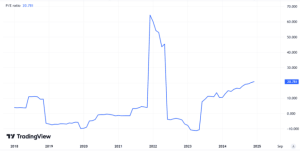Barclays (LSE:BARC) shares tanked on Thursday, despite the UK’s second-largest bank beating expectations, and reporting lower-than-anticipated impairment charges. So why did the stock fall, and why might this be a buying opportunity? Let’s explore.
Earnings beat
Let’s start with the good news. The bank reported earnings per share (EPS) of 8.6p for the second quarter, coming in above the 7.9p analysts had forecast. Attributable profit came in at £1.3bn, above estimates of £1.24bn, but below Q1’s £1.8bn.
While group income was lighter than expected by £200m, the better-than-expected earnings can be in part attributed to lower-than-forecast impairment charges. The group put aside £400m for bad debt during the quarter versus a forecast £597m.
Negatives overdone
Well, there is a narrative that we’re on a downward trajectory following stellar Q1 results. Despite performing ahead of analysts’ expectations, the bank’s earnings were significantly below Q1 in Q2, while Barclays also revised its net interest margin forecast for the year, down by five basis points to 3.15%. Coupled with a slowing economy, there are downside risks.
Barclays also missed targets within its corporate and investment bank income, which saw income dip 3% to £3.2bn, reflecting lower client activity in global markets and investment banking fees.
However, personally, I believe the sell-off is overdone. Analysts, before the earnings beat, were forecasting annual EPS of 32.6, meaning Barclays is currently trading with a forward price-to-earnings ratio of just 4.7 times. That’s extraordinarily cheap, especially considering the bank recently passed its stress test, relieving any fears that may have lingered from the SVB fiasco.
It’s worth noting that we normally associate a low price-to-earnings with a negative long-run growth trajectory. However, analysts are forecasting EPS to rise 9.2% to 35.6p in 2024, and then a further 10.7% to 39.4p in 2025. The bank trades at less than four times forecast earnings for 2025!
It’s also important to remember that while central bank interest rates will fall, thousands of households will be on fixed higher rate mortgages. Banks also hedge by buying bonds. So this particular interest rate tailwind won’t necessarily peter out in the near future.
With the share price falling, we’re also seeing the dividend yield push upwards, currently sitting at a very healthy 4.75%.
Looking longer term
Higher interest rates offer a huge tailwind, but there are concerns. Of course, when interest rates rise, borrowers are put under increasing pressure to meet rising repayments. In turn, this means more defaults and higher impairment charges for banks. That’s what we’re seeing, but it was more tangible in Lloyds‘ earnings report on Wednesday.
However, interest rates will likely begin to fall in the second half of the year or the first half of 2024, and I see this as a positive. Lenders perform best when central bank interest rates are around 2-3%. Here, net interest income will remain elevated versus the average over the last decade, while borrowers will likely find repayments more affordable.
As such, I believes there’s a very strong investment hypothesis for Barclays. That’s why I’m continuing to buy more.
This post was originally published on Motley Fool





